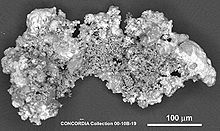 Micrometerorite collected from the Antarctic snow. |
A micrometeorite is a micrometeoroid that has survived entry through the Earth's atmosphere. Usually found on Earth's surface, micrometeorites differ from meteorites in that they are smaller in size, more abundant, and different in composition. The IAU officially defines meteoroids as 30 micrometers to 1 meter; micrometeorites are the small end of the range (~submillimeter).[1] They are a subset of cosmic dust, which also includes the smaller interplanetary dust particles (IDPs).[2]
Micrometeorites enter Earth's atmosphere at high velocities (at least 11 km/s) and undergo heating through atmospheric friction and compression. Micrometeorites individually weigh between 10−9 and 10−4 g and collectively comprise most of the extraterrestrial material that has come to the present-day Earth.[3]
Fred Lawrence Whipple first coined the term "micro-meteorite" to describe dust-sized objects that fall to the Earth.[4] Sometimes meteoroids and micrometeoroids entering the Earth's atmosphere are visible as meteors or "shooting stars", whether or not they reach the ground and survive as meteorites and micrometeorites.
- ^ "Definitions of terms in meteor astronomy" (PDF). Retrieved 25 Jul 2020.
- ^ Brownlee, D. E.; Bates, B.; Schramm, L. (1997), "The elemental composition of stony cosmic spherules", Meteoritics and Planetary Science, 32 (2): 157–175, Bibcode:1997M&PS...32..157B, doi:10.1111/j.1945-5100.1997.tb01257.x
- ^ Love, S. G.; Brownlee, D. E. (1993), "A direct measurement of the terrestrial mass accretion rate of cosmic dust", Science, 262 (5133): 550–553, Bibcode:1993Sci...262..550L, doi:10.1126/science.262.5133.550, PMID 17733236, S2CID 35563939
- ^ Whipple, Fred (1950), "The Theory of Micro-Meteorites", Proceedings of the National Academy of Sciences, 36 (12): 687–695, Bibcode:1950PNAS...36..687W, doi:10.1073/pnas.36.12.687, PMC 1063272, PMID 16578350